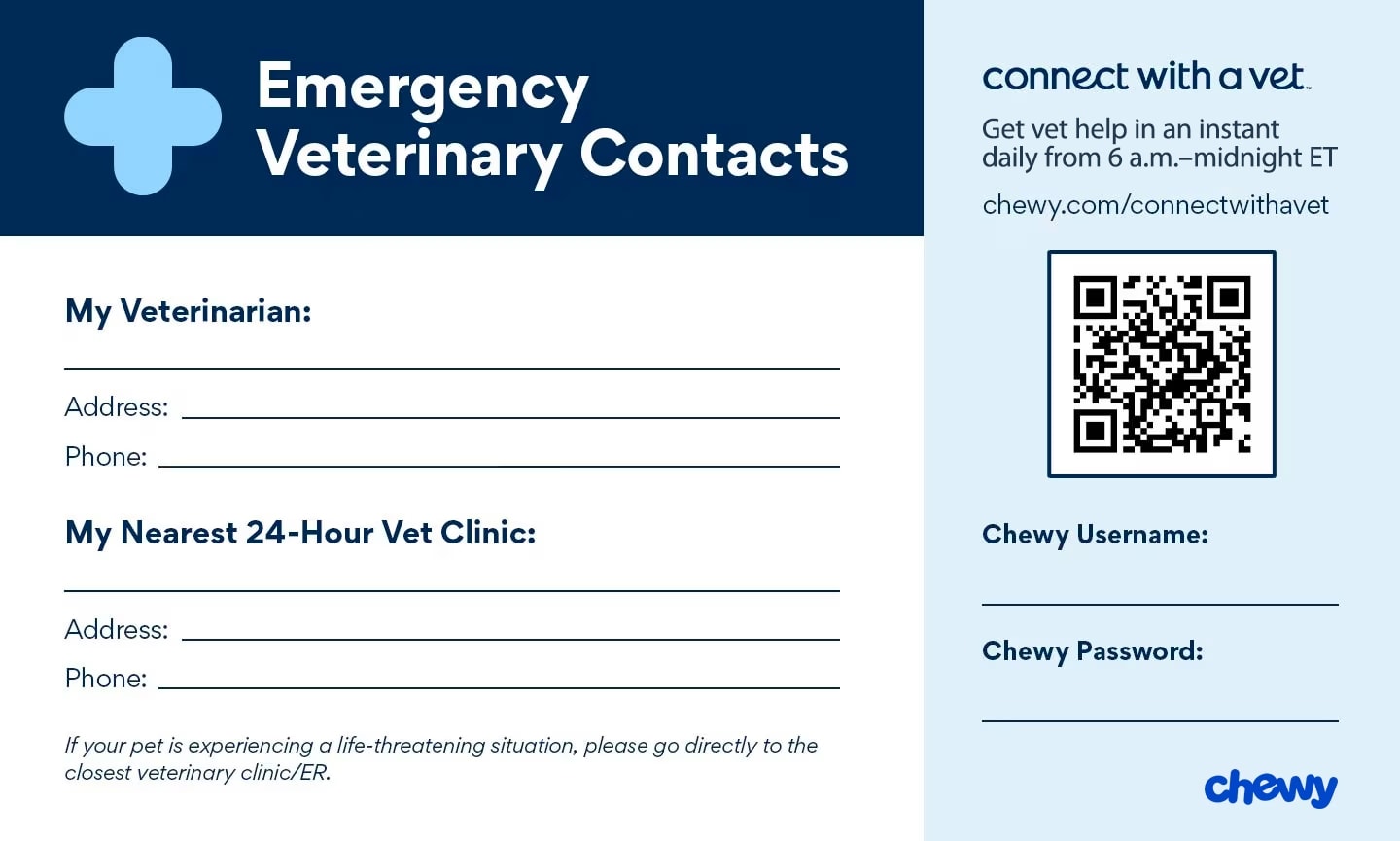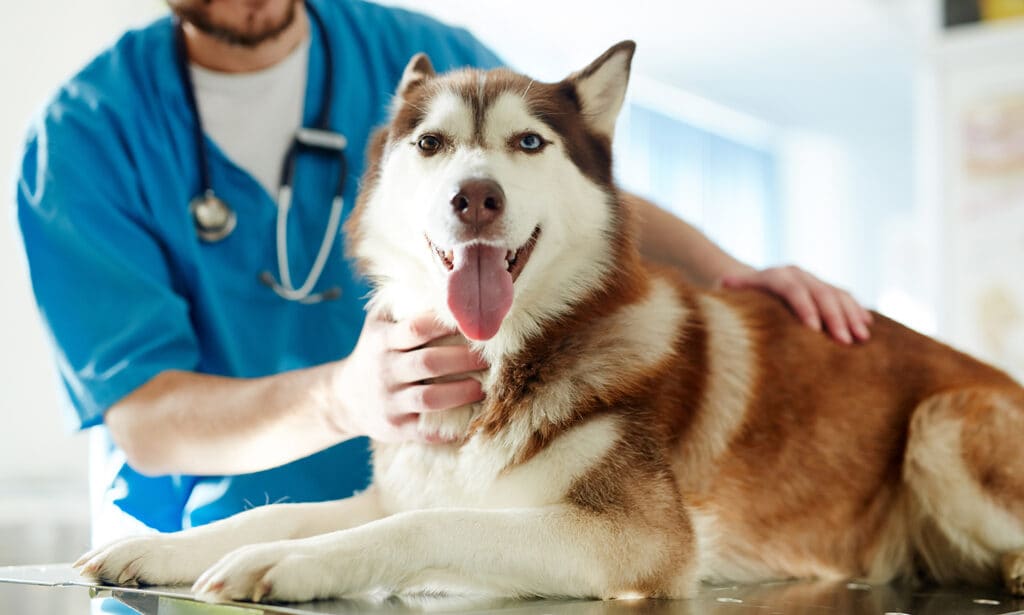Dogs are curious creatures. They explore the world around them using their senses, especially smell and taste. But that curiosity can lead our furry friends into trouble when they encounter something potentially poisonous or toxic.
Certain foods, chemicals, plants and fertilizers can all be toxic to dogs, and harmful exposure can happen through ingestion, inhalation and contact with the skin.
So, what do you do if you suspect your dog has been poisoned? We not only discuss the best steps to take to help your pup, but we also identify the signs of dog poisoning and more.
In This Guide:
Common Substances That Are Toxic to Dogs
Not sure whether that thing your dog just ate is dangerous? We’ve rounded up the most common substances that cause poisoning in dogs below—but keep in mind that this is not a complete list of dangerous substances for dogs.
If you are unsure whether your dog has been poisoned, it is best to contact a veterinarian or veterinary poison control hotline like the ones below for advice:
- Pet Poison Helpline: (855) 764-7661
- American Society for the Prevention of Animals (ASPCA) Animal Poison Control Center: (888) 426-4435
These are a few of the common poisons dogs may encounter:
Human Foods
Chocolate, caffeine, raisins, grapes, onions, garlic, alcohol, sugar-free items that contain xylitol
Over-the-Counter Medication
Cold medications, vitamins such as vitamin D3, antidepressant medications, pain relievers like acetaminophen, ibuprofen and naproxen
Home and Garden Products
Fertilizer and plant foods, antifreeze, pool chemicals, bleach, detergents, house paints, wood stains
Insecticides and Anti-Pest Products
Bug repellents, bug sprays, ant bait, roach baits, rat bait, slug and snail bait, gopher bait
Plants
Lily, sago palm, foxglove, mistletoe, oleander, dieffenbachia (Find out more about poisonous plants for pets.)
Signs of Dog Poisoning
The symptoms and signs of dog poisoning can vary, depending on the type of toxin and the part of the body affected. In addition, dog poisoning symptoms can develop very quickly or be delayed by several hours, making it difficult to know if poisoning occurred.
Symptoms that may indicate your dog has been poisoned include:
- Lethargy
- Diarrhea
- Vomiting
- Belly pain
- Loss of appetite
- Bleeding
- Tremors or convulsions
- Difficulty walking or loss of balance
- Rapid breathing
- Difficulty breathing
- Drooling or foaming from the mouth
- Changes in urination habits (more or less)
- Changes in drinking habits (more or less)
- Change in gum color (pale, gray, purple, dark red is all considered abnormal)
- Abnormal heartbeat or pulse
If you see these signs in your dog, or you suspect your pet has been poisoned, follow the steps below.
What To Do If Your Dog Is Poisoned: A Step-by-Step Guide
First things first: Stay calm. There are several things you can do to help your dog.
Step 1: Separate Your Pet from the Poison
If you witness your dog ingest or come into contact with a toxic substance, remove that substance from their reach immediately. This could mean moving it to a higher place your dog can’t reach, or in the case of a spill, removing your dog from the room without access to the area of the spill. This will prevent further ingestion or contact.
Step 2: Quickly Make Note of the Poison
Before you call or visit a veterinarian, quickly make note of the substance you believe has poisoned your dog. If you’re able to tell your vet exactly what your pup has ingested, that will help your veterinarian determine the best treatment.
If you’re headed to your vet’s office or a veterinary ER (more on that below), it’s a good idea to bring the toxic substance and/or its packaging with you—but only if you can safely do so. Do not risk exposure to yourself and others if you cannot safely transport the substance.
Not sure what poisoned your pet? Don’t worry—it’s OK to skip this step and move on to contacting or visiting a vet.
Step 3: Contact or see a veterinarian
How you proceed next will depend on your pet’s condition:
If your pet seems stable: Call a veterinarian for advice.
- This may be your primary care vet if the incident occurs during their business hours, or a 24-hour emergency vet for after-hours incidents.
- Poison control hotlines like ASPCA's Animal Poison Control Center (888-426-4435) and the Pet Poison Helpline (855-764-7661) can offer expert recommendations for your pet.
- Telehealth services such as Chewy’s Connect With a Vet can also provide advice and guidance on the next best steps. Be aware, this may include a recommendation to contact a veterinary poison control center or to head directly to a veterinary ER.
If your pet does not seem stable: Proceed to the closest veterinary hospital or ER.
If your dog shows these signs, they should be seen by a veterinarian right away:
- They have collapsed
- They have pale gums
- They are falling over
- They have a seizure
- They have difficulty breathing
Transporting a sick pet can be difficult for both you and your dog. Keep these tips in mind:
- If your pet has collapsed, lay them gently on the seat of the car as you transport them to the vet. Try to keep their head and neck extended so they can breathe easily.
- If your pet is actively vomiting, let them do so, then clear the vomit away at once.
- If possible, travel to the vet or veterinary ER with another person. One of you can care for your dog while the other drives.
- Remember to bring the toxic substance and/or its packaging with you—but only if you can safely do so. Do not risk exposure to yourself and others if you cannot safely transport the substance.
Should I Induce Vomiting?
No, do not induce vomiting unless your vet tells you to do so.
While it may seem like a good idea to induce vomiting if your dog has eaten something dangerous, it may not be appropriate or safe for your dog, and can do more harm than good in some situations. Do not try to make your dog vomit at home unless instructed to do so by a veterinarian.
Preparing for Pet Emergencies
The best way to prevent poisoning is to help your dog avoid contact with potentially harmful substances. Here are a few ways to keep your pup safe in and around your home:
- Keep medicines and supplements stored in closed containers away from your dog.
- Avoid feeding your pet human foods unless your veterinarian has verified it’s safe for them.
- Ensure things like fertilizers, plant food and other gardening materials are stored safely in an area your dog cannot access.
It’s also a good idea to have contact information for your dogs’ veterinarian, a pet poison control center like ASPCA (American Society for the Prevention of Cruelty to Animals or Pet Poison Helpline, and the closest 24-hour emergency vet readily available. A list posted to your refrigerator might seem old-fashioned, but it sure can come in handy during an emergency!
Download our handy Emergency Veterinary Contacts card, fill it out, and stick it to your fridge—you’ll be glad you did if you find yourself in a pet emergency.

If your pet takes medication write it down there, too. You can also ask your vet for a recent copy of their medical records to have on hand. This information can be useful during an emergency, especially if you end up going to a veterinary ER.
Having a pet first aid kit can also come in handy—not just for poisonings, but for injuries and other types of pet emergencies. Good items to include in your kit include:
- Fresh bottled water
- Dry, clean towels
- Antiseptic wipes, such as Douxo S3 PYO wipes
- Eye wash, such as Vetericyn Plus
- A thermometer, such as Vet-Temp Rapid Flexible Digital Thermometer
- Bandage material, like Andover Healthcare PetFlex Paw Print Bandage
Keep your dog safe:
Share:










